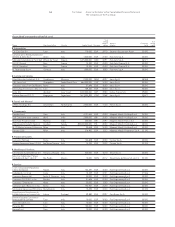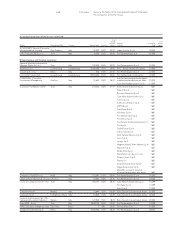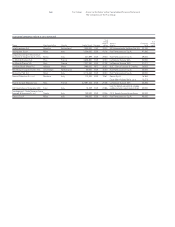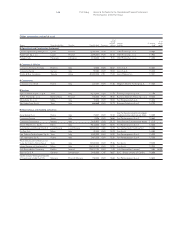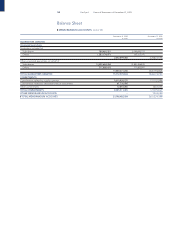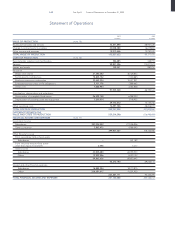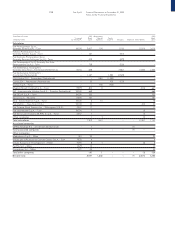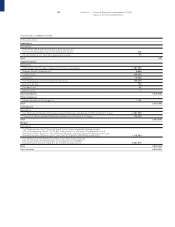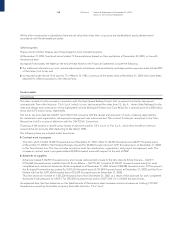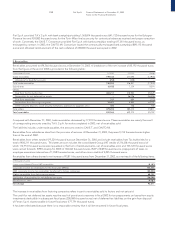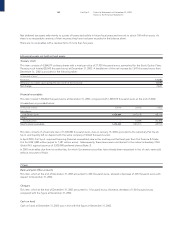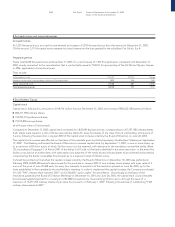Chrysler 2003 Annual Report Download - page 152
Download and view the complete annual report
Please find page 152 of the 2003 Chrysler annual report below. You can navigate through the pages in the report by either clicking on the pages listed below, or by using the keyword search tool below to find specific information within the annual report.
151 Fiat S.p.A. Financial Statements at December 31, 2003
Notes to the Financial Statements
ACCOUNTING PRINCIPLES AND METHODS
Consistently with the previous fiscal year, the financial
statements at December 31, 2003, which include the balance
sheet, the statement of operations and the notes to the financial
statements, have been prepared in accordance with the format
and regulations set forth in Legislative Decree No. 127 of April
9, 1991, and provide the additional information required by
CONSOB.
The valuation criteria used, which are discussed below, are
consistent with those used in previous fiscal years, and conform
to the provisions of Article 2426 of the Italian Civil Code.
In particular:
❚BALANCE SHEET
Intangible fixed assets
Start-up and expansion costs consist of costs incurred in
connection with capital increases. They are capitalized on the
basis of their estimated useful life. They are amortized on a
straight-line basis over five years; the available reserves exceed
not already amortized costs by a substantial amount.
Trademarks are recorded at a value that reflects only the
administrative cost of registration. To ensure a conservative
valuation, this amount is amortized on a straight-line basis
over three years.
The other intangible fixed assets are represented by the
commissions paid for organization of the convertible facility
granted in 2002. They are amortized on a pro-rated basis
according to the term of the facility.
Property, plant and equipment and depreciation
Property, plant and equipment is recorded at acquisition cost
plus directly attributable charges. As indicated in a separate
schedule, the value of some of these assets includes the
inflation adjustments required under the pertinent laws.
Improvement costs are added to the value of the asset in
question only when they permanently increase their value.
Depreciation is computed on a straight-line basis at rates
deemed adequate in view of the estimated useful life of the
assets. For assets acquired during the fiscal year, the annual
depreciation is taken at half the regular rate. The cost of
maintenance and repairs is charged directly to income when
incurred.
Financial fixed assets
Financial fixed assets include equity investments and other
securities.
Equity investments are shown in the balance sheet at their
historical cost and, more exactly, on the basis of the costs
incurred or, when business operations are transferred, at the
values set forth in the respective contracts in accordance with
the appraisals required by law, determined by the LIFO method
with annual adjustments. As shown in a separate schedule,
some of these assets have been adjusted for inflation, as
required by the relevant legislation.
Investments in companies that have suffered a permanent loss
in value are written down accordingly. If in subsequent fiscal
years the reasons for these adjustments are no longer valid, the
writedowns are reversed. No reversals are made for writedowns
recognized prior to the effective date of Decree Law No. 127/1991.
Other securities include securities shown at their net purchase
price, adjusted for the accrual of any premium or discount
earned or incurred upon issuance or purchase, because the
securities, which are pledged to fund scholarship grants, are
not held for trading purposes.
Inventories
Inventories include contract work in progress and advances to
suppliers.
Work in progress under long-term contracts (i.e. contracts
signed between Fiat and Treno Alta Velocità – T.A.V. S.p.A. in
connection with the High-Speed Railway Project, described in
Note 4) is valued on the basis of the respective production cost.
Amounts received from the bidder company T.A.V. S.p.A. while
work is in progress are treated as a form of financing and are
included among the liabilities under advances, while those paid
to the subcontracting consortia are booked under inventories –
advances to suppliers.
Revenues are booked when the work is actually delivered
and accepted by customers.
Treasury stock
Treasury stock is stated at the lower of purchase cost, determined
using the annual lot LIFO method and the average market price
for the last month of the fiscal year.
If in subsequent fiscal years the reasons for these adjustments
are no longer valid, the writedowns are reversed.
A corresponding treasury stock reserve for the same amount has
been recorded in the balance sheet under stockholders’ equity.
This reserve cannot be used to cover losses.
Receivables and payables
Accounts receivable are shown at their estimated realizable
value, which represents the difference between their face value
and the adjustments included in the allowance for doubtful
accounts. The individual items are shown in the balance sheet
net of the respective allowances.
Based on past experience, the amount of these allowances
is determined in accordance with a prudent estimate of
uncollectible amounts and reflects the risks associated
with specific delinquent accounts.


